Communication Event Analysis: A Gastroenterology Placement Report
VerifiedAdded on 2022/12/14
|9
|2041
|356
Report
AI Summary
This report provides an in-depth analysis of a communication event that occurred during a nursing student's gastroenterology placement. The analysis begins with a detailed description of the event, involving a physician, receptionist, colleague nurse, and the student, highlighting the challenges of a cardiac arrest situation and miscommunication. The report then delves into the communication processes, exploring linear, interactive, and transactional models, and how these models were applied or misapplied in the event. It evaluates the degree to which the communication processes complied with hospital policies and professional standards, identifying instances of effective communication and areas where improvements could be made. The student reflects on how the event influenced their communication style, emphasizing the importance of effective communication in healthcare, the need for patience and clarification, and the impact of persuasive language and diligence. The report concludes by discussing personal development efforts to enhance communication skills and adhere to workplace policies.
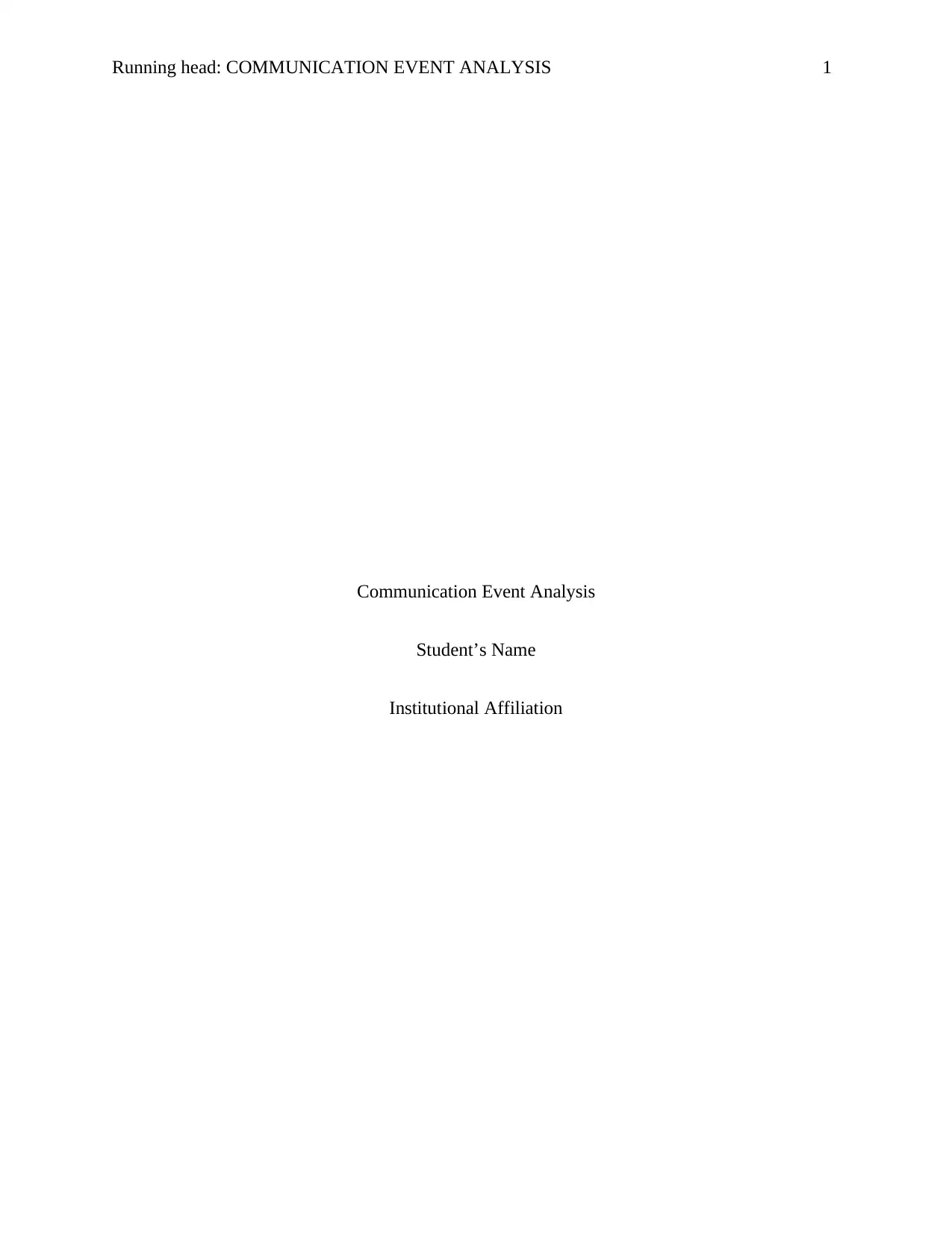
Running head: COMMUNICATION EVENT ANALYSIS 1
Communication Event Analysis
Student’s Name
Institutional Affiliation
Communication Event Analysis
Student’s Name
Institutional Affiliation
Paraphrase This Document
Need a fresh take? Get an instant paraphrase of this document with our AI Paraphraser
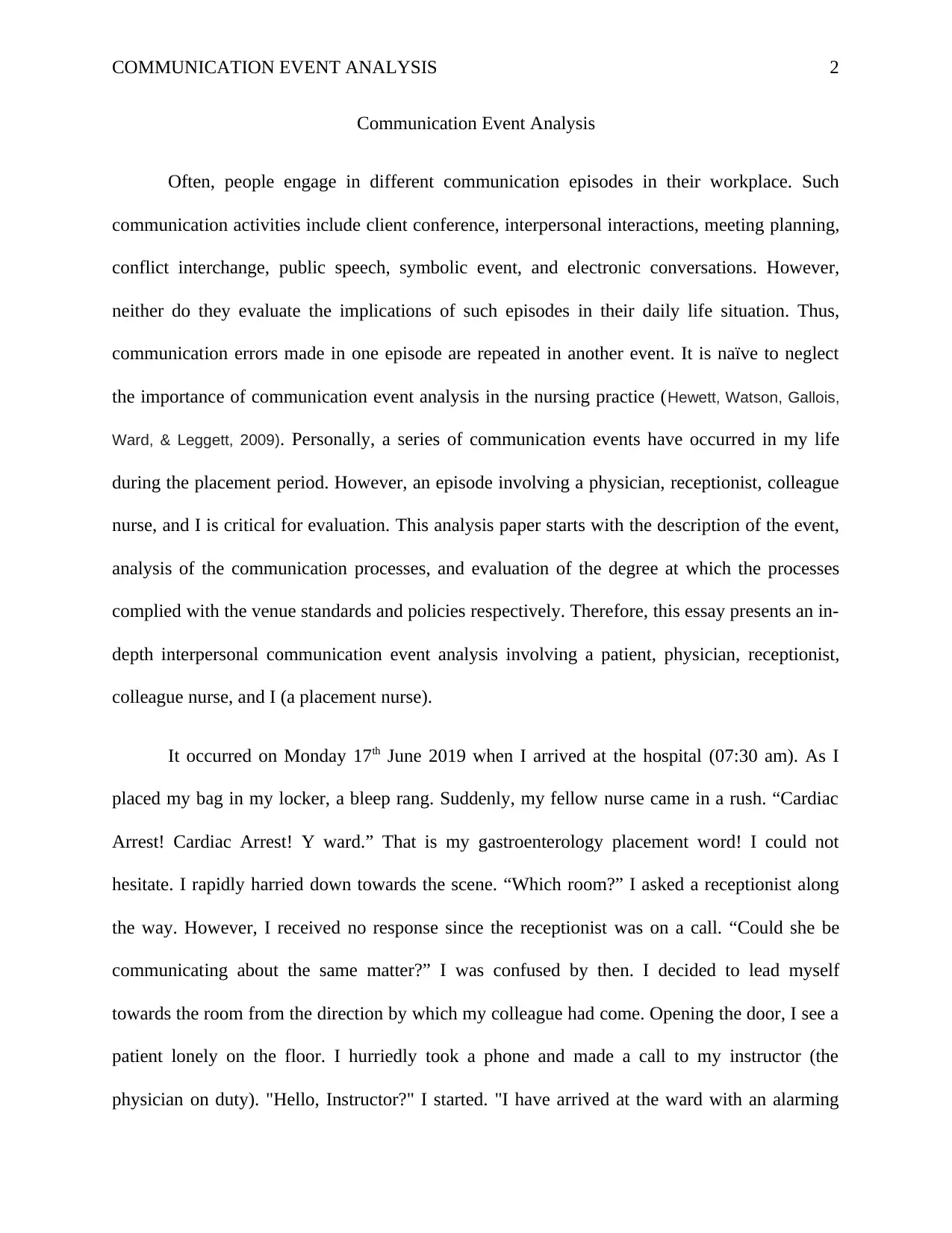
COMMUNICATION EVENT ANALYSIS 2
Communication Event Analysis
Often, people engage in different communication episodes in their workplace. Such
communication activities include client conference, interpersonal interactions, meeting planning,
conflict interchange, public speech, symbolic event, and electronic conversations. However,
neither do they evaluate the implications of such episodes in their daily life situation. Thus,
communication errors made in one episode are repeated in another event. It is naïve to neglect
the importance of communication event analysis in the nursing practice (Hewett, Watson, Gallois,
Ward, & Leggett, 2009). Personally, a series of communication events have occurred in my life
during the placement period. However, an episode involving a physician, receptionist, colleague
nurse, and I is critical for evaluation. This analysis paper starts with the description of the event,
analysis of the communication processes, and evaluation of the degree at which the processes
complied with the venue standards and policies respectively. Therefore, this essay presents an in-
depth interpersonal communication event analysis involving a patient, physician, receptionist,
colleague nurse, and I (a placement nurse).
It occurred on Monday 17th June 2019 when I arrived at the hospital (07:30 am). As I
placed my bag in my locker, a bleep rang. Suddenly, my fellow nurse came in a rush. “Cardiac
Arrest! Cardiac Arrest! Y ward.” That is my gastroenterology placement word! I could not
hesitate. I rapidly harried down towards the scene. “Which room?” I asked a receptionist along
the way. However, I received no response since the receptionist was on a call. “Could she be
communicating about the same matter?” I was confused by then. I decided to lead myself
towards the room from the direction by which my colleague had come. Opening the door, I see a
patient lonely on the floor. I hurriedly took a phone and made a call to my instructor (the
physician on duty). "Hello, Instructor?" I started. "I have arrived at the ward with an alarming
Communication Event Analysis
Often, people engage in different communication episodes in their workplace. Such
communication activities include client conference, interpersonal interactions, meeting planning,
conflict interchange, public speech, symbolic event, and electronic conversations. However,
neither do they evaluate the implications of such episodes in their daily life situation. Thus,
communication errors made in one episode are repeated in another event. It is naïve to neglect
the importance of communication event analysis in the nursing practice (Hewett, Watson, Gallois,
Ward, & Leggett, 2009). Personally, a series of communication events have occurred in my life
during the placement period. However, an episode involving a physician, receptionist, colleague
nurse, and I is critical for evaluation. This analysis paper starts with the description of the event,
analysis of the communication processes, and evaluation of the degree at which the processes
complied with the venue standards and policies respectively. Therefore, this essay presents an in-
depth interpersonal communication event analysis involving a patient, physician, receptionist,
colleague nurse, and I (a placement nurse).
It occurred on Monday 17th June 2019 when I arrived at the hospital (07:30 am). As I
placed my bag in my locker, a bleep rang. Suddenly, my fellow nurse came in a rush. “Cardiac
Arrest! Cardiac Arrest! Y ward.” That is my gastroenterology placement word! I could not
hesitate. I rapidly harried down towards the scene. “Which room?” I asked a receptionist along
the way. However, I received no response since the receptionist was on a call. “Could she be
communicating about the same matter?” I was confused by then. I decided to lead myself
towards the room from the direction by which my colleague had come. Opening the door, I see a
patient lonely on the floor. I hurriedly took a phone and made a call to my instructor (the
physician on duty). "Hello, Instructor?" I started. "I have arrived at the ward with an alarming
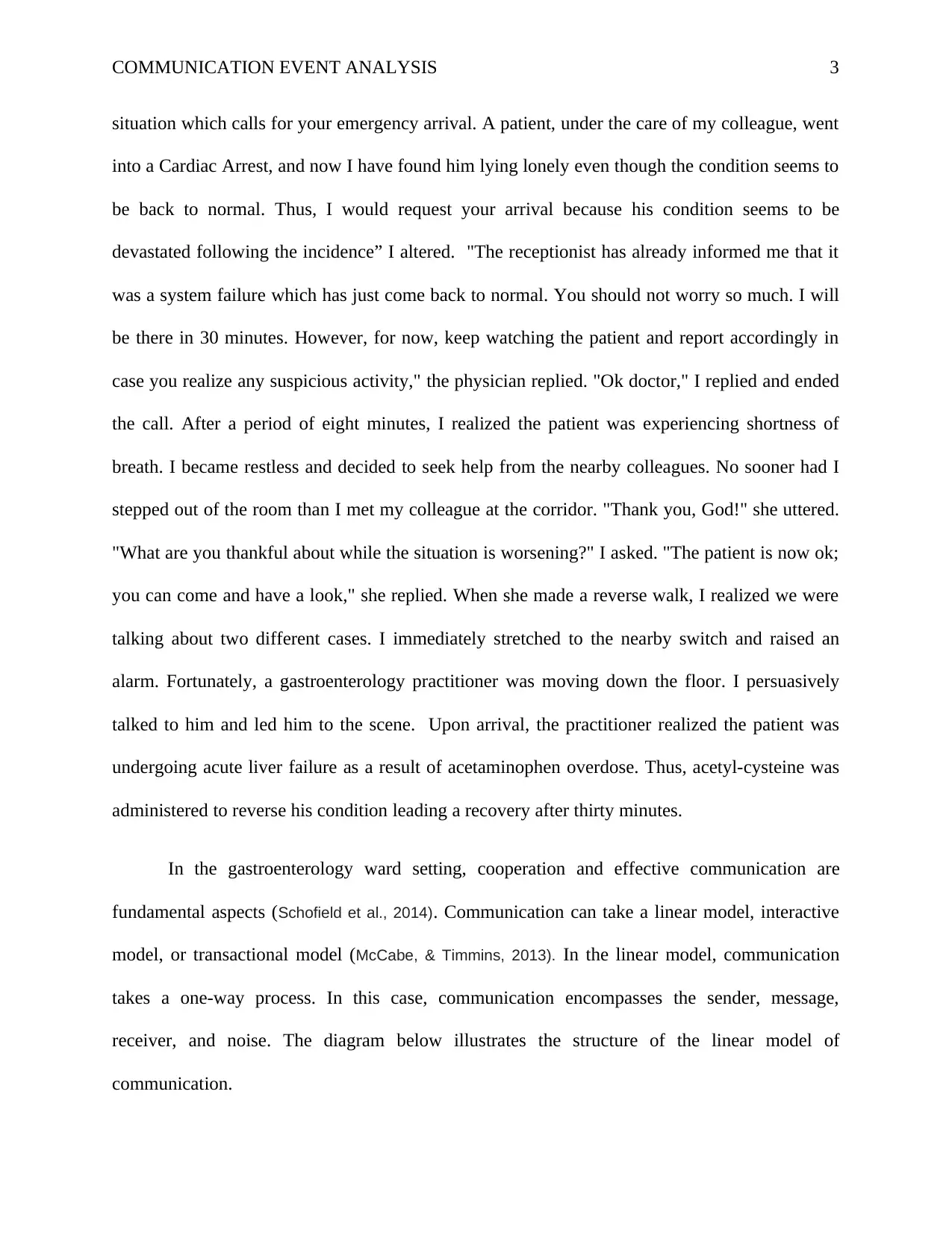
COMMUNICATION EVENT ANALYSIS 3
situation which calls for your emergency arrival. A patient, under the care of my colleague, went
into a Cardiac Arrest, and now I have found him lying lonely even though the condition seems to
be back to normal. Thus, I would request your arrival because his condition seems to be
devastated following the incidence” I altered. "The receptionist has already informed me that it
was a system failure which has just come back to normal. You should not worry so much. I will
be there in 30 minutes. However, for now, keep watching the patient and report accordingly in
case you realize any suspicious activity," the physician replied. "Ok doctor," I replied and ended
the call. After a period of eight minutes, I realized the patient was experiencing shortness of
breath. I became restless and decided to seek help from the nearby colleagues. No sooner had I
stepped out of the room than I met my colleague at the corridor. "Thank you, God!" she uttered.
"What are you thankful about while the situation is worsening?" I asked. "The patient is now ok;
you can come and have a look," she replied. When she made a reverse walk, I realized we were
talking about two different cases. I immediately stretched to the nearby switch and raised an
alarm. Fortunately, a gastroenterology practitioner was moving down the floor. I persuasively
talked to him and led him to the scene. Upon arrival, the practitioner realized the patient was
undergoing acute liver failure as a result of acetaminophen overdose. Thus, acetyl-cysteine was
administered to reverse his condition leading a recovery after thirty minutes.
In the gastroenterology ward setting, cooperation and effective communication are
fundamental aspects (Schofield et al., 2014). Communication can take a linear model, interactive
model, or transactional model (McCabe, & Timmins, 2013). In the linear model, communication
takes a one-way process. In this case, communication encompasses the sender, message,
receiver, and noise. The diagram below illustrates the structure of the linear model of
communication.
situation which calls for your emergency arrival. A patient, under the care of my colleague, went
into a Cardiac Arrest, and now I have found him lying lonely even though the condition seems to
be back to normal. Thus, I would request your arrival because his condition seems to be
devastated following the incidence” I altered. "The receptionist has already informed me that it
was a system failure which has just come back to normal. You should not worry so much. I will
be there in 30 minutes. However, for now, keep watching the patient and report accordingly in
case you realize any suspicious activity," the physician replied. "Ok doctor," I replied and ended
the call. After a period of eight minutes, I realized the patient was experiencing shortness of
breath. I became restless and decided to seek help from the nearby colleagues. No sooner had I
stepped out of the room than I met my colleague at the corridor. "Thank you, God!" she uttered.
"What are you thankful about while the situation is worsening?" I asked. "The patient is now ok;
you can come and have a look," she replied. When she made a reverse walk, I realized we were
talking about two different cases. I immediately stretched to the nearby switch and raised an
alarm. Fortunately, a gastroenterology practitioner was moving down the floor. I persuasively
talked to him and led him to the scene. Upon arrival, the practitioner realized the patient was
undergoing acute liver failure as a result of acetaminophen overdose. Thus, acetyl-cysteine was
administered to reverse his condition leading a recovery after thirty minutes.
In the gastroenterology ward setting, cooperation and effective communication are
fundamental aspects (Schofield et al., 2014). Communication can take a linear model, interactive
model, or transactional model (McCabe, & Timmins, 2013). In the linear model, communication
takes a one-way process. In this case, communication encompasses the sender, message,
receiver, and noise. The diagram below illustrates the structure of the linear model of
communication.
⊘ This is a preview!⊘
Do you want full access?
Subscribe today to unlock all pages.

Trusted by 1+ million students worldwide
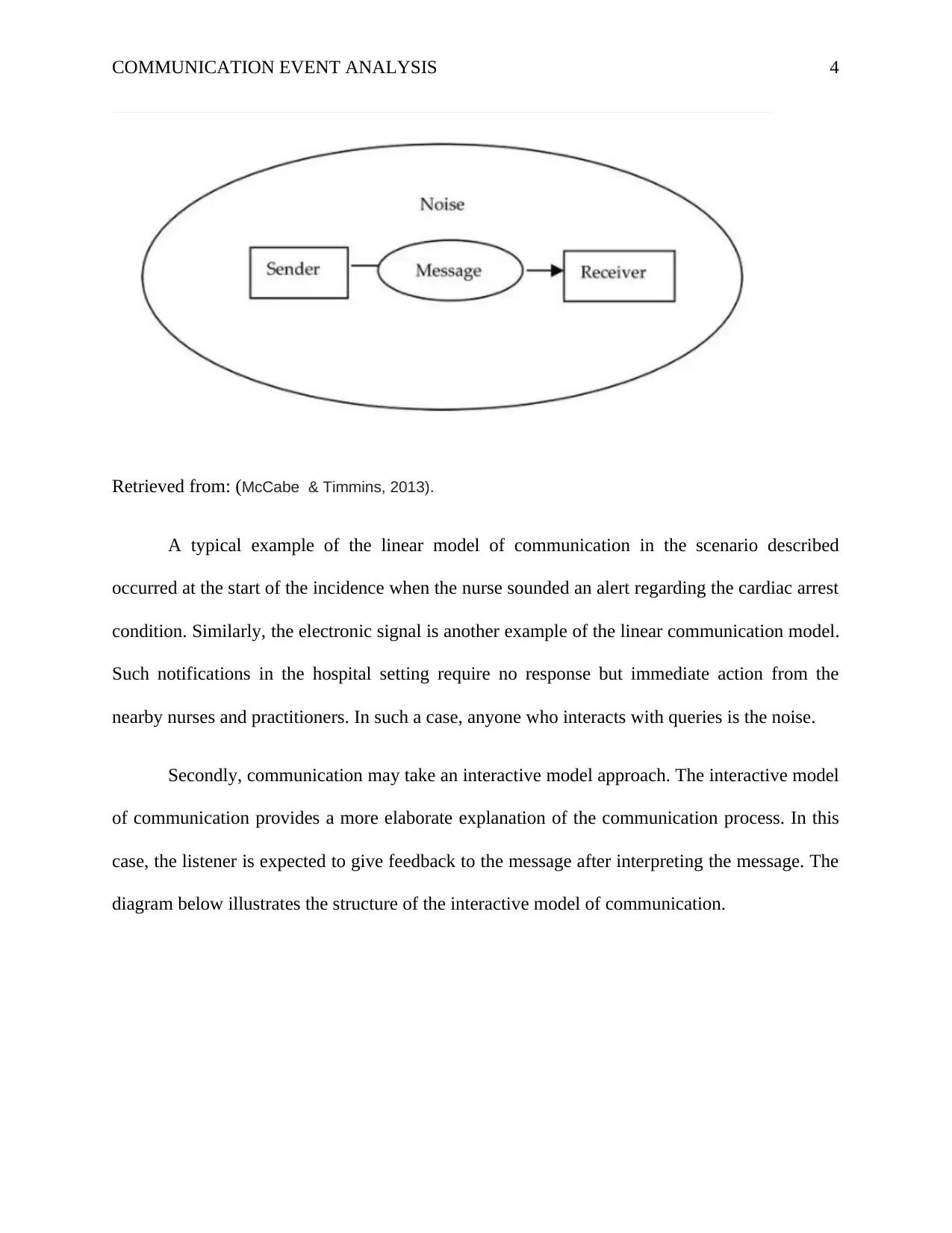
COMMUNICATION EVENT ANALYSIS 4
Retrieved from: (McCabe & Timmins, 2013).
A typical example of the linear model of communication in the scenario described
occurred at the start of the incidence when the nurse sounded an alert regarding the cardiac arrest
condition. Similarly, the electronic signal is another example of the linear communication model.
Such notifications in the hospital setting require no response but immediate action from the
nearby nurses and practitioners. In such a case, anyone who interacts with queries is the noise.
Secondly, communication may take an interactive model approach. The interactive model
of communication provides a more elaborate explanation of the communication process. In this
case, the listener is expected to give feedback to the message after interpreting the message. The
diagram below illustrates the structure of the interactive model of communication.
Retrieved from: (McCabe & Timmins, 2013).
A typical example of the linear model of communication in the scenario described
occurred at the start of the incidence when the nurse sounded an alert regarding the cardiac arrest
condition. Similarly, the electronic signal is another example of the linear communication model.
Such notifications in the hospital setting require no response but immediate action from the
nearby nurses and practitioners. In such a case, anyone who interacts with queries is the noise.
Secondly, communication may take an interactive model approach. The interactive model
of communication provides a more elaborate explanation of the communication process. In this
case, the listener is expected to give feedback to the message after interpreting the message. The
diagram below illustrates the structure of the interactive model of communication.
Paraphrase This Document
Need a fresh take? Get an instant paraphrase of this document with our AI Paraphraser
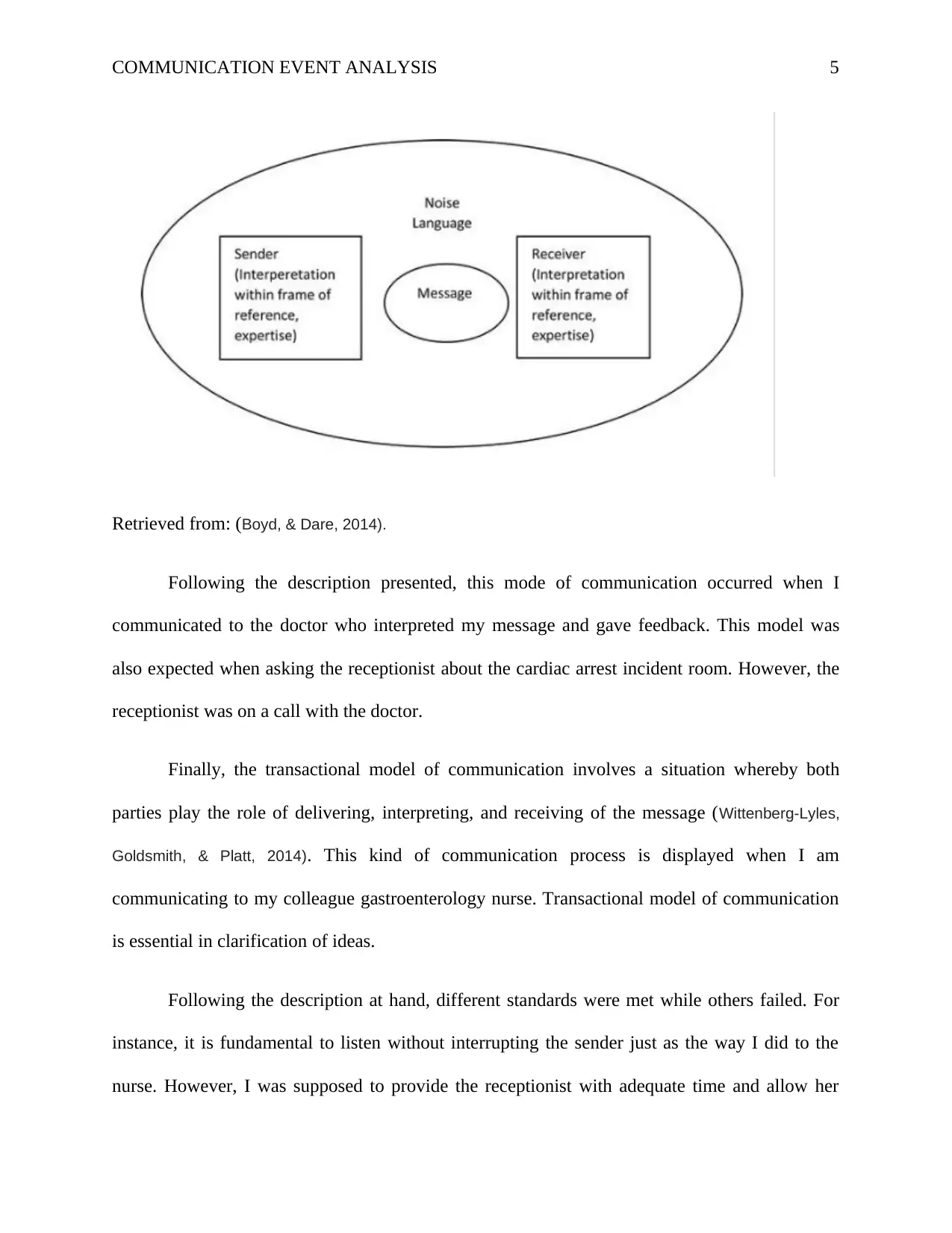
COMMUNICATION EVENT ANALYSIS 5
Retrieved from: (Boyd, & Dare, 2014).
Following the description presented, this mode of communication occurred when I
communicated to the doctor who interpreted my message and gave feedback. This model was
also expected when asking the receptionist about the cardiac arrest incident room. However, the
receptionist was on a call with the doctor.
Finally, the transactional model of communication involves a situation whereby both
parties play the role of delivering, interpreting, and receiving of the message (Wittenberg-Lyles,
Goldsmith, & Platt, 2014). This kind of communication process is displayed when I am
communicating to my colleague gastroenterology nurse. Transactional model of communication
is essential in clarification of ideas.
Following the description at hand, different standards were met while others failed. For
instance, it is fundamental to listen without interrupting the sender just as the way I did to the
nurse. However, I was supposed to provide the receptionist with adequate time and allow her
Retrieved from: (Boyd, & Dare, 2014).
Following the description presented, this mode of communication occurred when I
communicated to the doctor who interpreted my message and gave feedback. This model was
also expected when asking the receptionist about the cardiac arrest incident room. However, the
receptionist was on a call with the doctor.
Finally, the transactional model of communication involves a situation whereby both
parties play the role of delivering, interpreting, and receiving of the message (Wittenberg-Lyles,
Goldsmith, & Platt, 2014). This kind of communication process is displayed when I am
communicating to my colleague gastroenterology nurse. Transactional model of communication
is essential in clarification of ideas.
Following the description at hand, different standards were met while others failed. For
instance, it is fundamental to listen without interrupting the sender just as the way I did to the
nurse. However, I was supposed to provide the receptionist with adequate time and allow her
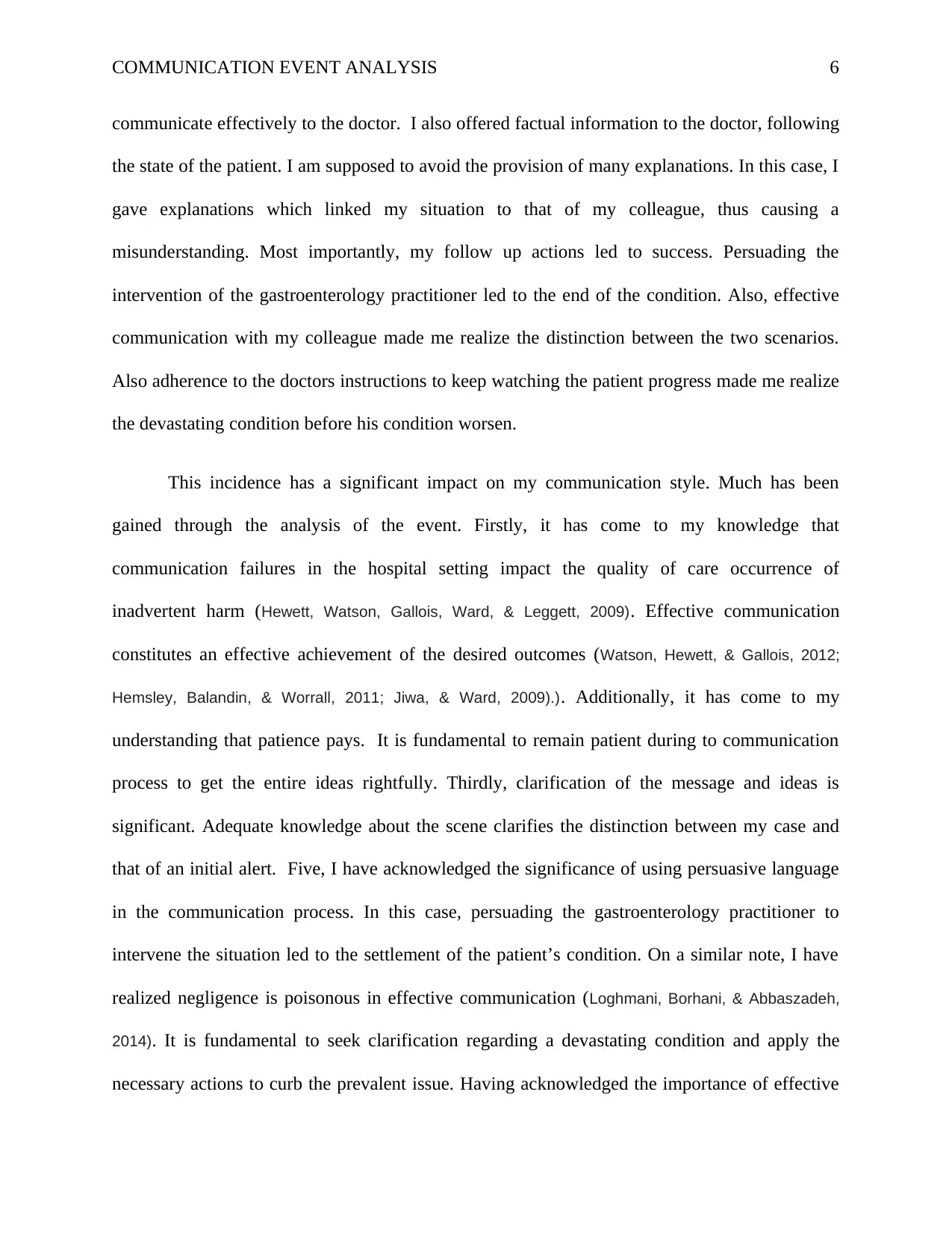
COMMUNICATION EVENT ANALYSIS 6
communicate effectively to the doctor. I also offered factual information to the doctor, following
the state of the patient. I am supposed to avoid the provision of many explanations. In this case, I
gave explanations which linked my situation to that of my colleague, thus causing a
misunderstanding. Most importantly, my follow up actions led to success. Persuading the
intervention of the gastroenterology practitioner led to the end of the condition. Also, effective
communication with my colleague made me realize the distinction between the two scenarios.
Also adherence to the doctors instructions to keep watching the patient progress made me realize
the devastating condition before his condition worsen.
This incidence has a significant impact on my communication style. Much has been
gained through the analysis of the event. Firstly, it has come to my knowledge that
communication failures in the hospital setting impact the quality of care occurrence of
inadvertent harm (Hewett, Watson, Gallois, Ward, & Leggett, 2009). Effective communication
constitutes an effective achievement of the desired outcomes (Watson, Hewett, & Gallois, 2012;
Hemsley, Balandin, & Worrall, 2011; Jiwa, & Ward, 2009).). Additionally, it has come to my
understanding that patience pays. It is fundamental to remain patient during to communication
process to get the entire ideas rightfully. Thirdly, clarification of the message and ideas is
significant. Adequate knowledge about the scene clarifies the distinction between my case and
that of an initial alert. Five, I have acknowledged the significance of using persuasive language
in the communication process. In this case, persuading the gastroenterology practitioner to
intervene the situation led to the settlement of the patient’s condition. On a similar note, I have
realized negligence is poisonous in effective communication (Loghmani, Borhani, & Abbaszadeh,
2014). It is fundamental to seek clarification regarding a devastating condition and apply the
necessary actions to curb the prevalent issue. Having acknowledged the importance of effective
communicate effectively to the doctor. I also offered factual information to the doctor, following
the state of the patient. I am supposed to avoid the provision of many explanations. In this case, I
gave explanations which linked my situation to that of my colleague, thus causing a
misunderstanding. Most importantly, my follow up actions led to success. Persuading the
intervention of the gastroenterology practitioner led to the end of the condition. Also, effective
communication with my colleague made me realize the distinction between the two scenarios.
Also adherence to the doctors instructions to keep watching the patient progress made me realize
the devastating condition before his condition worsen.
This incidence has a significant impact on my communication style. Much has been
gained through the analysis of the event. Firstly, it has come to my knowledge that
communication failures in the hospital setting impact the quality of care occurrence of
inadvertent harm (Hewett, Watson, Gallois, Ward, & Leggett, 2009). Effective communication
constitutes an effective achievement of the desired outcomes (Watson, Hewett, & Gallois, 2012;
Hemsley, Balandin, & Worrall, 2011; Jiwa, & Ward, 2009).). Additionally, it has come to my
understanding that patience pays. It is fundamental to remain patient during to communication
process to get the entire ideas rightfully. Thirdly, clarification of the message and ideas is
significant. Adequate knowledge about the scene clarifies the distinction between my case and
that of an initial alert. Five, I have acknowledged the significance of using persuasive language
in the communication process. In this case, persuading the gastroenterology practitioner to
intervene the situation led to the settlement of the patient’s condition. On a similar note, I have
realized negligence is poisonous in effective communication (Loghmani, Borhani, & Abbaszadeh,
2014). It is fundamental to seek clarification regarding a devastating condition and apply the
necessary actions to curb the prevalent issue. Having acknowledged the importance of effective
⊘ This is a preview!⊘
Do you want full access?
Subscribe today to unlock all pages.

Trusted by 1+ million students worldwide
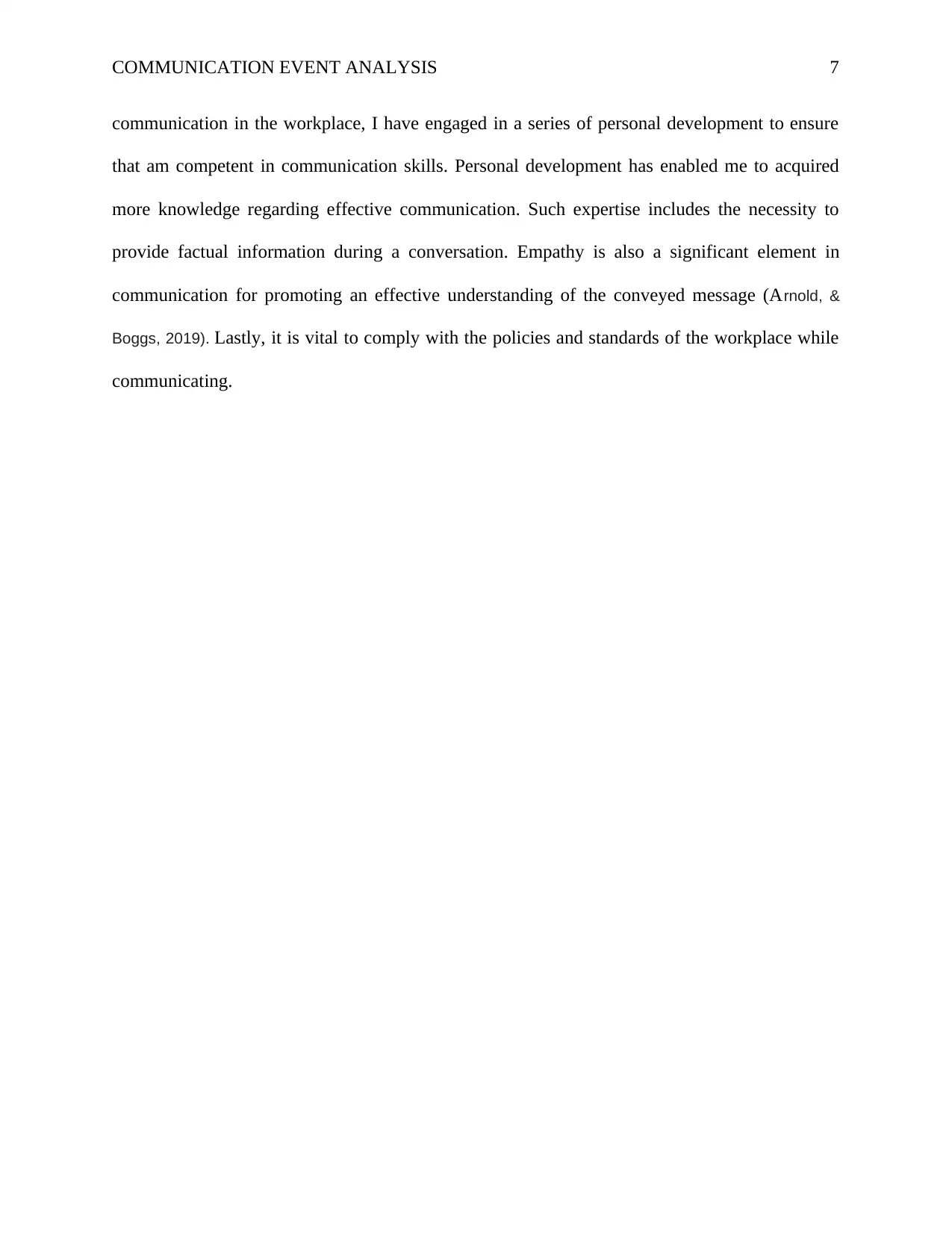
COMMUNICATION EVENT ANALYSIS 7
communication in the workplace, I have engaged in a series of personal development to ensure
that am competent in communication skills. Personal development has enabled me to acquired
more knowledge regarding effective communication. Such expertise includes the necessity to
provide factual information during a conversation. Empathy is also a significant element in
communication for promoting an effective understanding of the conveyed message (Arnold, &
Boggs, 2019). Lastly, it is vital to comply with the policies and standards of the workplace while
communicating.
communication in the workplace, I have engaged in a series of personal development to ensure
that am competent in communication skills. Personal development has enabled me to acquired
more knowledge regarding effective communication. Such expertise includes the necessity to
provide factual information during a conversation. Empathy is also a significant element in
communication for promoting an effective understanding of the conveyed message (Arnold, &
Boggs, 2019). Lastly, it is vital to comply with the policies and standards of the workplace while
communicating.
Paraphrase This Document
Need a fresh take? Get an instant paraphrase of this document with our AI Paraphraser
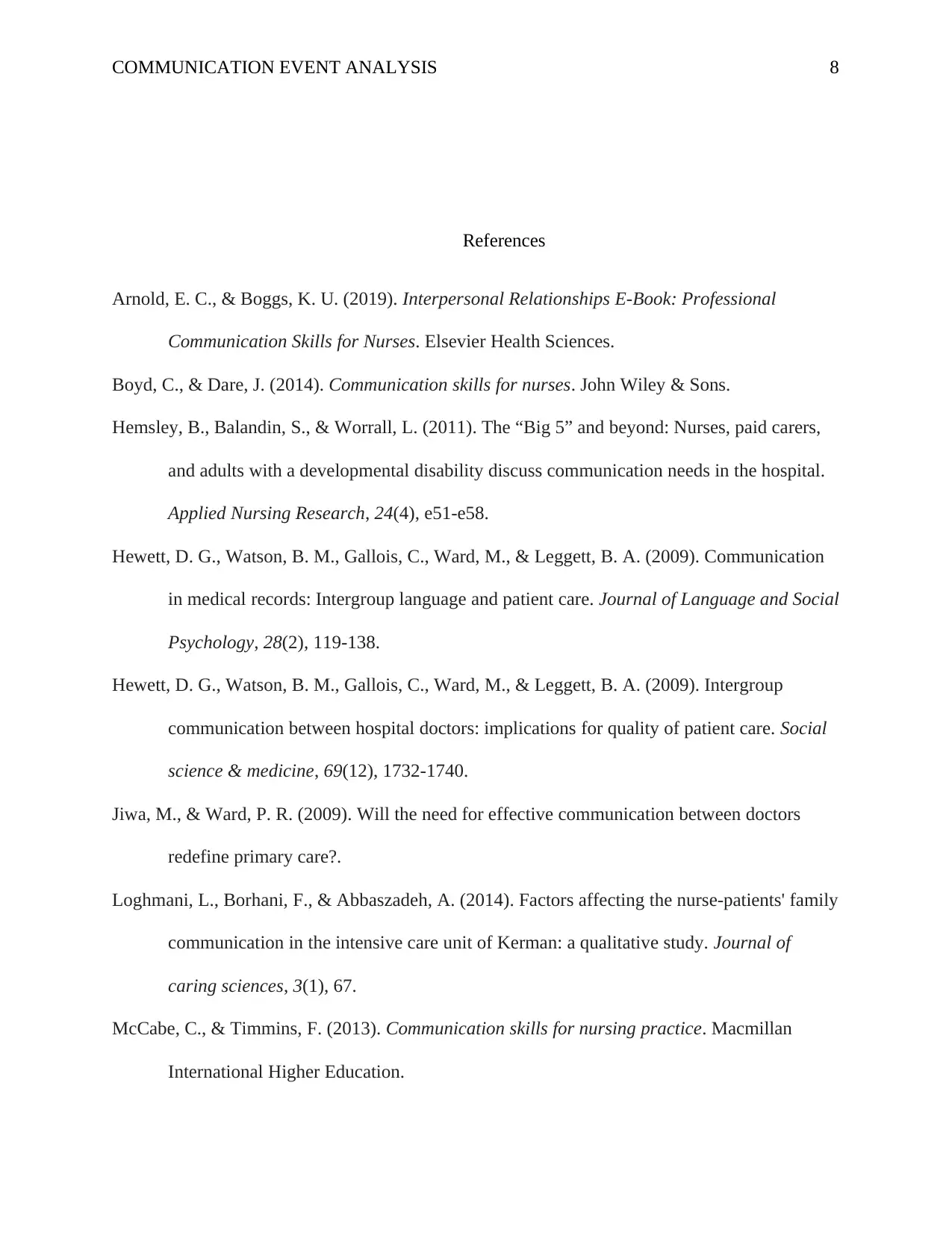
COMMUNICATION EVENT ANALYSIS 8
References
Arnold, E. C., & Boggs, K. U. (2019). Interpersonal Relationships E-Book: Professional
Communication Skills for Nurses. Elsevier Health Sciences.
Boyd, C., & Dare, J. (2014). Communication skills for nurses. John Wiley & Sons.
Hemsley, B., Balandin, S., & Worrall, L. (2011). The “Big 5” and beyond: Nurses, paid carers,
and adults with a developmental disability discuss communication needs in the hospital.
Applied Nursing Research, 24(4), e51-e58.
Hewett, D. G., Watson, B. M., Gallois, C., Ward, M., & Leggett, B. A. (2009). Communication
in medical records: Intergroup language and patient care. Journal of Language and Social
Psychology, 28(2), 119-138.
Hewett, D. G., Watson, B. M., Gallois, C., Ward, M., & Leggett, B. A. (2009). Intergroup
communication between hospital doctors: implications for quality of patient care. Social
science & medicine, 69(12), 1732-1740.
Jiwa, M., & Ward, P. R. (2009). Will the need for effective communication between doctors
redefine primary care?.
Loghmani, L., Borhani, F., & Abbaszadeh, A. (2014). Factors affecting the nurse-patients' family
communication in the intensive care unit of Kerman: a qualitative study. Journal of
caring sciences, 3(1), 67.
McCabe, C., & Timmins, F. (2013). Communication skills for nursing practice. Macmillan
International Higher Education.
References
Arnold, E. C., & Boggs, K. U. (2019). Interpersonal Relationships E-Book: Professional
Communication Skills for Nurses. Elsevier Health Sciences.
Boyd, C., & Dare, J. (2014). Communication skills for nurses. John Wiley & Sons.
Hemsley, B., Balandin, S., & Worrall, L. (2011). The “Big 5” and beyond: Nurses, paid carers,
and adults with a developmental disability discuss communication needs in the hospital.
Applied Nursing Research, 24(4), e51-e58.
Hewett, D. G., Watson, B. M., Gallois, C., Ward, M., & Leggett, B. A. (2009). Communication
in medical records: Intergroup language and patient care. Journal of Language and Social
Psychology, 28(2), 119-138.
Hewett, D. G., Watson, B. M., Gallois, C., Ward, M., & Leggett, B. A. (2009). Intergroup
communication between hospital doctors: implications for quality of patient care. Social
science & medicine, 69(12), 1732-1740.
Jiwa, M., & Ward, P. R. (2009). Will the need for effective communication between doctors
redefine primary care?.
Loghmani, L., Borhani, F., & Abbaszadeh, A. (2014). Factors affecting the nurse-patients' family
communication in the intensive care unit of Kerman: a qualitative study. Journal of
caring sciences, 3(1), 67.
McCabe, C., & Timmins, F. (2013). Communication skills for nursing practice. Macmillan
International Higher Education.
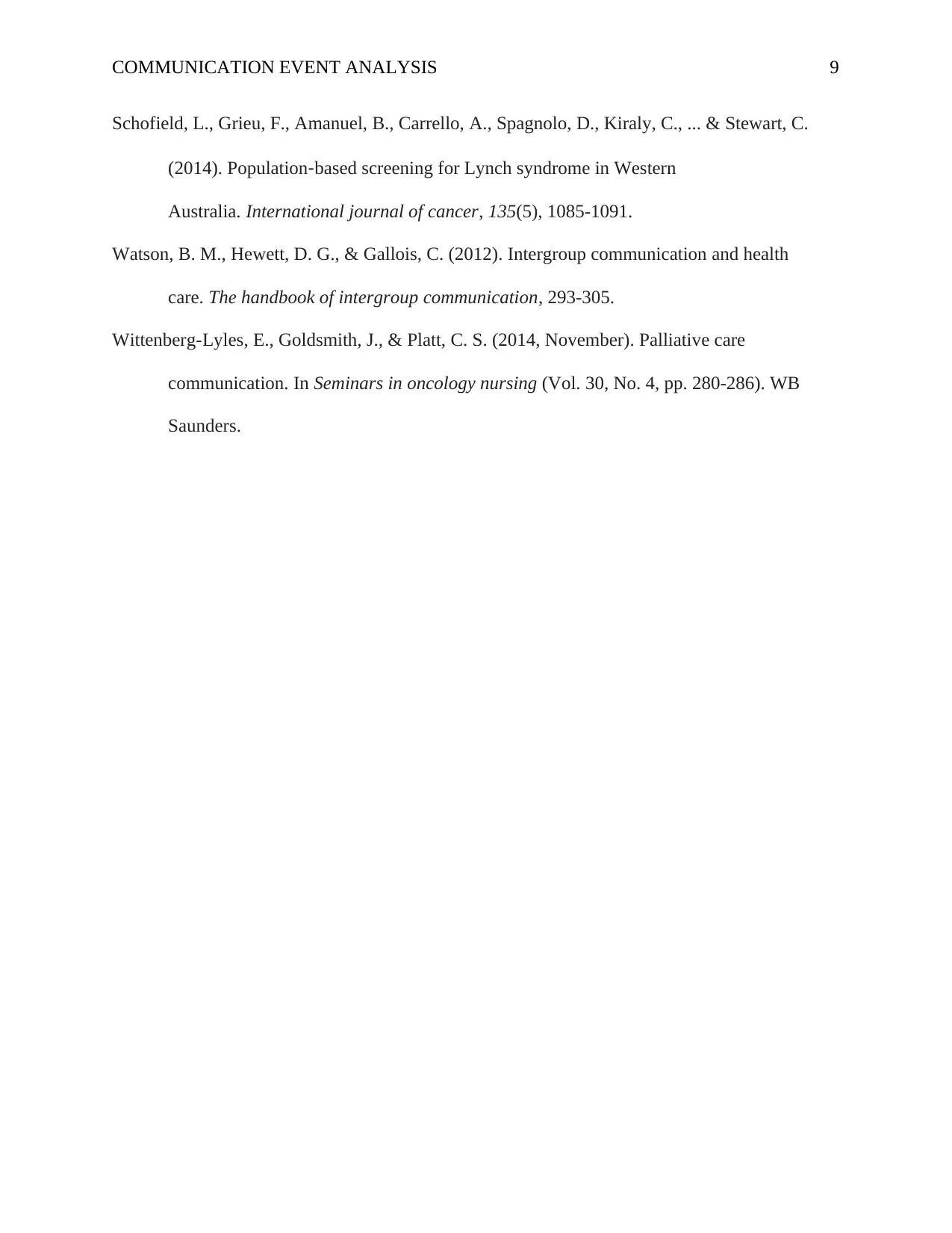
COMMUNICATION EVENT ANALYSIS 9
Schofield, L., Grieu, F., Amanuel, B., Carrello, A., Spagnolo, D., Kiraly, C., ... & Stewart, C.
(2014). Population‐based screening for Lynch syndrome in Western
Australia. International journal of cancer, 135(5), 1085-1091.
Watson, B. M., Hewett, D. G., & Gallois, C. (2012). Intergroup communication and health
care. The handbook of intergroup communication, 293-305.
Wittenberg-Lyles, E., Goldsmith, J., & Platt, C. S. (2014, November). Palliative care
communication. In Seminars in oncology nursing (Vol. 30, No. 4, pp. 280-286). WB
Saunders.
Schofield, L., Grieu, F., Amanuel, B., Carrello, A., Spagnolo, D., Kiraly, C., ... & Stewart, C.
(2014). Population‐based screening for Lynch syndrome in Western
Australia. International journal of cancer, 135(5), 1085-1091.
Watson, B. M., Hewett, D. G., & Gallois, C. (2012). Intergroup communication and health
care. The handbook of intergroup communication, 293-305.
Wittenberg-Lyles, E., Goldsmith, J., & Platt, C. S. (2014, November). Palliative care
communication. In Seminars in oncology nursing (Vol. 30, No. 4, pp. 280-286). WB
Saunders.
⊘ This is a preview!⊘
Do you want full access?
Subscribe today to unlock all pages.

Trusted by 1+ million students worldwide
1 out of 9
Related Documents
Your All-in-One AI-Powered Toolkit for Academic Success.
+13062052269
info@desklib.com
Available 24*7 on WhatsApp / Email
![[object Object]](/_next/static/media/star-bottom.7253800d.svg)
Unlock your academic potential
Copyright © 2020–2025 A2Z Services. All Rights Reserved. Developed and managed by ZUCOL.



